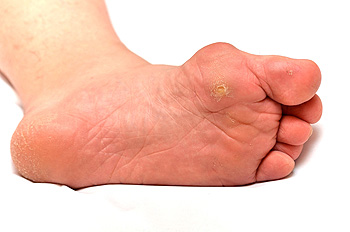Items filtered by date: August 2020
Caring for Diabetic Foot Ulcers
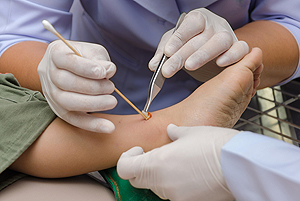 We should all be wary of cuts, scrapes, and wounds on our feet, but diabetics need to be especially careful. Diabetic foot ulcers are open sores or wounds that form mainly on the bottoms of the feet of people with diabetes. These wounds are slow to heal and may become infected. Therefore, it is important for diabetics to take special care of their feet. Daily inspections of the feet to check for scrapes, sores, and blisters, can help detect any problems early on. If you find an open wound, wash it well with saline or clean tap water, then apply antibiotic ointment to the wound. Cover the wound with a bandage to protect it, and change the bandage every one to two days, making sure to clean and disinfect the wound again. Keep pressure off the wound as much as you can to aid in healing. If you have diabetes and struggle with diabetic foot ulcers, see a podiatrist who can help you take care of your feet.
We should all be wary of cuts, scrapes, and wounds on our feet, but diabetics need to be especially careful. Diabetic foot ulcers are open sores or wounds that form mainly on the bottoms of the feet of people with diabetes. These wounds are slow to heal and may become infected. Therefore, it is important for diabetics to take special care of their feet. Daily inspections of the feet to check for scrapes, sores, and blisters, can help detect any problems early on. If you find an open wound, wash it well with saline or clean tap water, then apply antibiotic ointment to the wound. Cover the wound with a bandage to protect it, and change the bandage every one to two days, making sure to clean and disinfect the wound again. Keep pressure off the wound as much as you can to aid in healing. If you have diabetes and struggle with diabetic foot ulcers, see a podiatrist who can help you take care of your feet.
Wound care is an important part in dealing with diabetes. If you have diabetes and a foot wound or would like more information about wound care for diabetics, consult with one of our podiatrists from Advanced Ankle & Foot Surgeons. Our doctors will assess your condition and provide you with quality foot and ankle treatment.
What Is Wound Care?
Wound care is the practice of taking proper care of a wound. This can range from the smallest to the largest of wounds. While everyone can benefit from proper wound care, it is much more important for diabetics. Diabetics often suffer from poor blood circulation which causes wounds to heal much slower than they would in a non-diabetic.
What Is the Importance of Wound Care?
While it may not seem apparent with small ulcers on the foot, for diabetics, any size ulcer can become infected. Diabetics often also suffer from neuropathy, or nerve loss. This means they might not even feel when they have an ulcer on their foot. If the wound becomes severely infected, amputation may be necessary. Therefore, it is of the upmost importance to properly care for any and all foot wounds.
How to Care for Wounds
The best way to care for foot wounds is to prevent them. For diabetics, this means daily inspections of the feet for any signs of abnormalities or ulcers. It is also recommended to see a podiatrist several times a year for a foot inspection. If you do have an ulcer, run the wound under water to clear dirt from the wound; then apply antibiotic ointment to the wound and cover with a bandage. Bandages should be changed daily and keeping pressure off the wound is smart. It is advised to see a podiatrist, who can keep an eye on it.
If you have any questions, please feel free to contact our office located in O'Fallon, and New Baden, IL . We offer the newest diagnostic and treatment technologies for all your foot care needs.
Caring for Your Child’s Ingrown Toenail
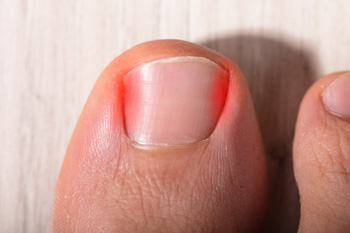 Ingrown toenails can be difficult to deal with, especially for pediatric patients. To help prevent your child from developing an ingrown toenail, it’s important that you do not trim their toenails too short, and that you do not put footwear or socks on that are too tight for their feet. If your child has an existing ingrown toenail, it can be helpful to soak their feet, as well as help them to avoid putting pressure on the affected foot. In more serious cases, the ingrown toenail can become infected. Usually an infection can be recognized by increased swelling or redness, blisters may form, and the child can develop a fever. To help care for your child’s ingrown toenail, it’s recommended that you seek the professional advice and care of a podiatrist.
Ingrown toenails can be difficult to deal with, especially for pediatric patients. To help prevent your child from developing an ingrown toenail, it’s important that you do not trim their toenails too short, and that you do not put footwear or socks on that are too tight for their feet. If your child has an existing ingrown toenail, it can be helpful to soak their feet, as well as help them to avoid putting pressure on the affected foot. In more serious cases, the ingrown toenail can become infected. Usually an infection can be recognized by increased swelling or redness, blisters may form, and the child can develop a fever. To help care for your child’s ingrown toenail, it’s recommended that you seek the professional advice and care of a podiatrist.
Ingrown toenails can become painful if they are not treated properly. For more information about ingrown toenails, contact one of our podiatrists of Advanced Ankle & Foot Surgeons. Our doctors can provide the care you need to keep you pain-free and on your feet.
Ingrown Toenails
Ingrown toenails occur when a toenail grows sideways into the bed of the nail, causing pain, swelling, and possibly infection.
Causes
- Bacterial infections
- Improper nail cutting such as cutting it too short or not straight across
- Trauma to the toe, such as stubbing, which causes the nail to grow back irregularly
- Ill-fitting shoes that bunch the toes too close together
- Genetic predisposition
Prevention
Because ingrown toenails are not something found outside of shoe-wearing cultures, going barefoot as often as possible will decrease the likeliness of developing ingrown toenails. Wearing proper fitting shoes and using proper cutting techniques will also help decrease your risk of developing ingrown toenails.
Treatment
Ingrown toenails are a very treatable foot condition. In minor cases, soaking the affected area in salt or antibacterial soaps will not only help with the ingrown nail itself, but also help prevent any infections from occurring. In more severe cases, surgery is an option. In either case, speaking to your podiatrist about this condition will help you get a better understanding of specific treatment options that are right for you.
If you have any questions please feel free to contact our office located in O'Fallon, and New Baden, IL . We offer the newest diagnostic and treatment technologies for all your foot and ankle needs.
How Vitamins Can Help Prevent Cracked Heels
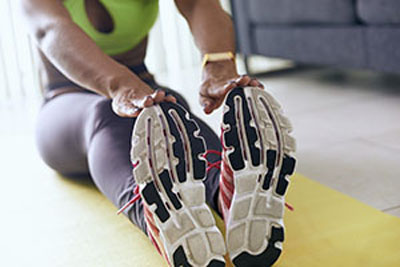 Cracked heels can be unpleasant to look at and may also cause a great deal of foot pain if left untreated. In serious cases, the cracks may turn into fissures, which are deep cracks in the skin that can lead to bleeding. While cracked heels are linked to dryness of the skin, they may also form due to a vitamin deficiency. If you aren’t getting the proper vitamin intake, the skin may become dry, dull, and prematurely age. Vitamin E is particularly beneficial in protecting collagen in your skin, and can be found in foods such as avocados, mangos, and salmon. For more information on what vitamins may help the prevention of cracked heels, please consult with a podiatrist.
Cracked heels can be unpleasant to look at and may also cause a great deal of foot pain if left untreated. In serious cases, the cracks may turn into fissures, which are deep cracks in the skin that can lead to bleeding. While cracked heels are linked to dryness of the skin, they may also form due to a vitamin deficiency. If you aren’t getting the proper vitamin intake, the skin may become dry, dull, and prematurely age. Vitamin E is particularly beneficial in protecting collagen in your skin, and can be found in foods such as avocados, mangos, and salmon. For more information on what vitamins may help the prevention of cracked heels, please consult with a podiatrist.
If the skin on your feet starts to crack, you may want to see a podiatrist to find treatment. If you have any concerns, contact one of our podiatrists from Advanced Ankle & Foot Surgeons. Our doctors can provide the care you need to keep you pain-free and on your feet.
Cracked Heels
It is important to moisturize your cracked heels in order to prevent pain, bleeding, and infection. The reason cracked heels form is because the skin on the foot is too dry to support the immense pressure placed on them. When the foot expands, the dry skin on the foot begins to split.
Ways to Help Heal Them
- Invest in a good foot cream
- Try Using Petroleum Jelly
- Ease up on Soaps
- Drink Plenty of Water
Ways to Prevent Cracked Heels
- Moisturize After Showering
- Skip a Shower
- Keep Shower Water Lukewarm
- Don’t Scrub Your Feet
If you are unsure how to proceed in treating cracked heels, seek guidance from a podiatrist. Your doctor will help you with any questions or information you may need.
If you have any questions, please feel free to contact our office located in O'Fallon, and New Baden, IL . We offer the newest diagnostic and treatment technologies for all your foot care needs.
Do I Have a Bunion?
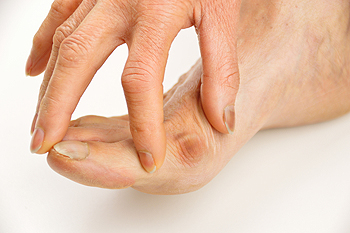 Bunions are bony lumps that are on the side of the foot next to the big toe. Some common symptoms include the big toe pointing towards the other toes or hardened and red skin over the bump. Bunions may also cause pain on the bottom or side of the foot when walking or wearing shoes. If you are experiencing pain from a bunion, some tips include wearing wide shoes with a soft sole, using bunion pads, or losing weight. If the pain is getting worse, or you have diabetes, it is important to consult with a podiatrist. A podiatrist can provide options for pain relief, and bunions can only be removed via surgery from a podiatric surgeon.
Bunions are bony lumps that are on the side of the foot next to the big toe. Some common symptoms include the big toe pointing towards the other toes or hardened and red skin over the bump. Bunions may also cause pain on the bottom or side of the foot when walking or wearing shoes. If you are experiencing pain from a bunion, some tips include wearing wide shoes with a soft sole, using bunion pads, or losing weight. If the pain is getting worse, or you have diabetes, it is important to consult with a podiatrist. A podiatrist can provide options for pain relief, and bunions can only be removed via surgery from a podiatric surgeon.
If you are suffering from bunions, contact one of our podiatrists of Advanced Ankle & Foot Surgeons. Our doctors can provide the care you need to keep you pain-free and on your feet.
What Is a Bunion?
A bunion is formed of swollen tissue or an enlargement of boney growth, usually located at the base joint of the toe that connects to the foot. The swelling occurs due to the bones in the big toe shifting inward, which impacts the other toes of the foot. This causes the area around the base of the big toe to become inflamed and painful.
Why Do Bunions Form?
Genetics – Susceptibility to bunions are often hereditary
Stress on the feet – Poorly fitted and uncomfortable footwear that places stress on feet, such as heels, can worsen existing bunions
How Are Bunions Diagnosed?
Doctors often perform two tests – blood tests and x-rays – when trying to diagnose bunions, especially in the early stages of development. Blood tests help determine if the foot pain is being caused by something else, such as arthritis, while x-rays provide a clear picture of your bone structure to your doctor.
How Are Bunions Treated?
- Refrain from wearing heels or similar shoes that cause discomfort
- Select wider shoes that can provide more comfort and reduce pain
- Anti-inflammatory and pain management drugs
- Orthotics or foot inserts
- Surgery
If you have any questions, please feel free to contact our office located in O'Fallon, and New Baden, IL . We offer the newest diagnostic and treatment technologies for all your foot care needs.
What Are Corns?
A corn is a type of callus or hardened skin that develops on the toes and feet due to consistent friction and pressure. Corns appear as raised hard bumps surrounded by dry flaky skin, and they may be tender and painful to the touch. Since corns are typically caused by friction and pressure, the first step in both prevention and treatment, is to wear comfortable properly-fitted shoes that do not irritate or squeeze your foot. Wearing shoe inserts or custom orthotics can provide cushioning and support for the feet. It is said that soaking and moisturizing the feet may relieve some of the pain caused by corns. However, some painful corns do not improve with at home remedies and need to be examined by a doctor. If you have painful corns on your feet it is suggested that you visit a podiatrist.
Corns can make walking very painful and should be treated immediately. If you have questions regarding your feet and ankles, contact one of our podiatrists of Advanced Ankle & Foot Surgeons. Our doctors will treat your foot and ankle needs.
Corns: What Are They? And How Do You Get Rid of Them?
Corns are thickened areas on the skin that can become painful. They are caused by excessive pressure and friction on the skin. Corns press into the deeper layers of the skin and are usually round in shape.
Ways to Prevent Corns
There are many ways to get rid of painful corns such as:
- Wearing properly fitting shoes that have been measured by a professional
- Wearing shoes that are not sharply pointed or have high heels
- Wearing only shoes that offer support
Treating Corns
Although most corns slowly disappear when the friction or pressure stops, this isn’t always the case. Consult with your podiatrist to determine the best treatment option for your case of corns.
If you have any questions please feel free to contact our office located in O'Fallon, and New Baden, IL . We offer the newest diagnostic and treatment technologies for all your foot and ankle needs.
